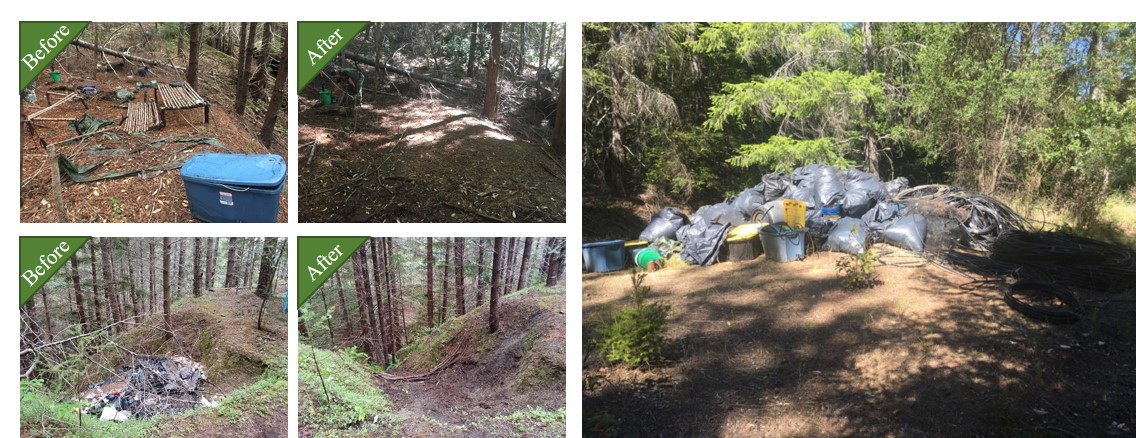Project Goals
The project aimed to cleanup six trespass cannabis cultivation sites located in the headwaters of South Fork Usal Creek. All cultivation infrastructure, toxins, and trash would be removed, and hazardous waste disposed of at a hazardous waste facility. The removal of the materials would protect fish and wildlife from exposure in Usal Creek. Infrastructure removal would also occur, including, but not limited to, water collection systems and fencing to deter future trespass growing at the sites.
Project Accomplishments and Ecosystem Outcomes
Six trespass cannabis cultivation sites were cleaned up in the South Fork Usal Creek watershed. All cultivation infrastructure, toxins and trash were removed from the six sites. In total, 3,500 pounds of refuse was removed, including over 2.2 miles of poly pipe, 1.5 gallons of liquid hazardous waste and 20 pounds of solid hazardous waste. In the winter following cleanup, 100 redwood trees were planted in areas that had been cleared of trees for cannabis cultivation activities.
Specifically:
- Approximately 0.3 pounds of rodenticide was found during the cleanup, most of the containers were empty, but there were some rodenticide pellets that could have poisoned wildlife. Rodenticide can work its way up the food chain and sicken or kill non-target species. The project removed this threat to wildlife.
- About 1.25 gallons of Sevin brand insecticide was removed, which is extremely toxic to fish. The removal of 0.25 gallons of an unidentified oil also occurred. All project sites were within a few hundred feet or less of seasonal streams which input directly into salmonid bearing creeks. Removing liquid toxins helps protect listed salmonid species from harm.
- Removal of 20 pounds of dry fertilizer. Fertilizer can cause algae blooms in creeks leading to blue-green algae poisoning of wildlife. Removing this substance from areas where it can get into waterways is key to keeping algae blooms at a minimum.
- Two of the project sites had substantial bird netting and fishing line strung along the cultivation site borders in order to control wildlife entry to the sites. Removing the netting and fishing line not only eliminates the habitat fragmentation caused by the barriers, but also prevents wildlife from entanglement and strangulation.
- A majority of the garbage found at the sites was food refuse. Though this food may smell attractive to wildlife it is not nutritionally supportive; it was all spoiled and moldy and eating it can lead to the ingestion of packaging as well. Wildlife that eat human food out of garbage piles may also become habituated to humans which puts them in danger.
- Three water diversions were removed, all of which were gravity fed. One diversion had a small pump to assist in the diversion. At the time of the project, the diversions were not operational. Based on a rough total estimate of 3,000 plants grown each year, the infrastructure removed could have been delivering about 2,361,000 gallons per season (787 gallons per plant).
This project was a partnership between Eel River Watershed Improvement Group (ERWIG), Redwood Forest Foundation Inc. (RFFI), Integral Ecology Research Center (IERC), and the California Conservation Corps (CCC). Financial support was provided by the CDFW Cannabis Restoration Grant Program. Additionally, the CCC contributed $10,027 of in-kind services and RFFI contributed $1,920 of in-kind services.
 Trespass campsite (top left) and garbage dump (bottom left) before and after clean-up efforts (top and bottom right), and all refuse materials ready for pick up and disposal (right). Photos courtesy of the Watershed Restoration Grant Program and Eel River Watershed Improvement Group.
Trespass campsite (top left) and garbage dump (bottom left) before and after clean-up efforts (top and bottom right), and all refuse materials ready for pick up and disposal (right). Photos courtesy of the Watershed Restoration Grant Program and Eel River Watershed Improvement Group.